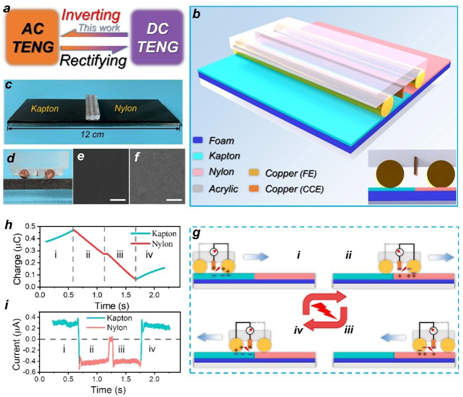On August 23, 2021, Energy & Environmental Science published a research paper titled “An inverting TENG to realize the AC mode d on the coupling of triboelectrification and air-breakdown” by the research group led by Professor Hu Chenguo of the School of Physics, Chongqing University. Chongqing University is the only organization of the paper. Shan Chuncai, a doctoral candidate of Chongqing University, is the first author. Professor Hu Chenguo, Associate Professor Liu Anping and Doctor Liu Wenlin (currently a post doctor at Peking University) of Chongqing University are corresponding co-authors.
With the rapid development of Internet of Things technology, the social need for distributed electronic devices increases tremendously. In particular, the self-driving technology with energy self-supply characteristics is drawing increasing attention. Triboelectric Nanogenerator (TENG) is an emerging technology that can convert various mechanical energy in the environment into electrical energy. In addition, due to its high voltage, it can also be used to sense mechanical motion with high sensitivity. At present, there are two output modes of Triboelectric Nanogenerator. One is AC output mode based on friction electrification and electrostatic induction coupling, and the other is DC output mode based on friction electrification and air breakdown coupling. As we all know, AC to DC conversion can be realized through rectification effect. From the perspective of symmetry demonstration, there should be an inverter output mechanism based on the coupling of friction electrification and air breakdown (i.e. DC to AC output). However, there are at present no reports on the inverter output mode of Triboelectric Nanogenerator. Therefore, exploring a new output mode of Triboelectric Nanogenerator with novel characteristics is of great significance to the improvement of TENG technology.
In this research paper, the effective coupling between friction electrification and air breakdown was realized through the friction material distribution designed with alternating polarity for the first time, and an inverter Triboelectric Nanogenerator (I-TENG) which can convert DC output to AC output was successfully constructed. Different from the fixed output waveform of traditional AC mode, I-TENG realizes the adjustable pulse width ratio and amplitude ratio of AC signal for the first time. Specifically, it changes the pulse width ratio and amplitude ratio of AC signal by adjusting the distribution width and electronegativity difference of two opposite polarity friction materials. Based on this, a real-time computer simulation trolley displacement and direction controller was designed to change the trolley movement distance by adjusting the sliding distance on one material. More importantly, when the slider moves to another friction material, the trolley can change the movement direction, which shows that this is a very sensitive and efficient control system. The research verified the symmetrical output mechanism of Triboelectric Nanogenerator. The unique output properties of I-TENG give it more advantages in building future self-powered intelligent system.
Link of the paper: https://pubs.rsc.org/en/content/articlelanding/2021/ee/d1ee01641e/unauth

Figures: (a) Schematic Diagram of DC and AC Output Mode Conversion. (b) Three-dimensional Structure Diagram of Inverter Triboelectric Nanogenerator. (c) Actual Device Diagram of Inverter Triboelectric Nanogenerator. (d) Contact Diagram of The Mover and Stator of the Triboelectric Nanogenerator clearly shows that there is a gap between the charge collection electrode and the friction surface. (e) SEM of Polyimide Film. (f) SEM of Nylon Film. (g) Working Principle Diagram of Inverter Triboelectric Nanogenerator. (h) Charge Output Curve. (i) Current Output Curve.
